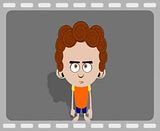Hi folks,
Sorry about the late reply, but I had some problems here in these months. I am building the project again, but I have some comments and suggestions for Synfig ( can I do it? ) .
First, The animated scenes ( I am editing the scenes in Blender ):
Well, as you can see, I’ve changed some styles…the boy is different and without outlines; I’ve added some brush strokes in inkscape using tablet with pressure ( nice result, I think! ).
Here, the boy prepared for animation in Synfig:
I had some problems with the boy because I created it in Inkscape and converted to synfig using the SVG2Sif; but the file is too huge and when I imported it inside of the scene file, the boy was huge, and inverted horizontally and vertically. My solutions was: I used the rotate layer and the stretch layer ( with negative value in the horizontal axis ) to use the boy in the scene. Well, it’s done, but with some work. Question 1: Is there another way to configure the file created with the svg2sif to fit the synfig world values? Did I make myself clear with this question?
Problem 2: the rotation layer show a very small blue dot with the file created with svg2sif; I mean, the blue dot is too close to the green one, so it’s difficult to grab it for rotation. Question : Is there a way to increase this distance between the blue dot and the green one?
Another question: Is there a way to see only the outlines to improve performance? The performance issue is the negative point in synfig.
Sorry about all of these questions, but I am trying to collaborate with synfig too.
I have 3 more scenes not animated yet, and I am working hard on then this weekend; next week I’ll be back…it’s a promise!
Please, answer me. I am trying to do a good animation with synfig.
P.S.: I am using the 1920x1080 resolution ( HDV full ).











